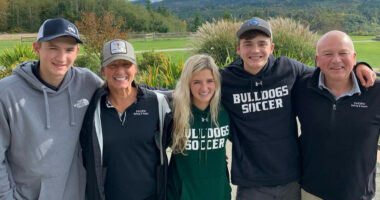
To include your event in the Briefing and Live Calendar, please fill out this form.
Weather: Mostly cloudy. A chance of showers and thunderstorms in the morning, then showers and thunderstorms likely in the afternoon. Highs in the upper 80s. East winds 5 to 10 mph. Chance of rain 70 percent. Friday Night: Mostly cloudy with a chance of showers with a slight chance of thunderstorms. Lows in the lower 70s. East winds around 5 mph. Chance of rain 50 percent.
- Daily weather briefing from the National Weather Service in Jacksonville here.
- Drought conditions here. (What is the Keetch-Byram drought index?).
- Check today’s tides in Daytona Beach (a few minutes off from Flagler Beach) here.
- tropical cyclone activity here, and even more details here.
Today at a Glance:

Free For All Fridays with Host David Ayres, an hour-long public affairs radio show featuring local newsmakers, personalities, public health updates and the occasional surprise guest, starts a little after 9 a.m. after FlaglerLive Editor Pierre Tristam’s Reality Check. Today: the winners of Tuesday’s election, and what’s next. See previous podcasts here. On WNZF at 94.9 FM and 1550 AM.
The Scenic A1A Pride Committee meets at 9 a.m. at the Hammock Community Center, 79 Mala Compra Road, Palm Coast. The meetings are open to the public.
The Flagler County Canvassing Board meets today at 10 a.m. and again at 2 p.m. at the Flagler County Supervisor of Elections office, Government Services Building, 1769 East Moody Boulevard, Bunnell. The meeting is open to the public. The morning meeting will include a review of provisional and other problem ballots. The 2 p.m. meeting, assuming the board votes to go ahead with a recount, will include a full machine recount to determine the winner of two close races. See: “Ed Danko’s Chance of Flipping Result Is Remote as Provisional Ballots and Recount Steps Ahead Are Mapped Out.”
The Blue 24 Forum, a discussion group organized by local Democrats, meets at 12:15 p.m. at the Palm Coast Community Center, 305 Palm Coast Parkway NE. Come and add your voice to local, state and national political issues.
Acoustic Jam Circle At The Community Center In The Hammock, 2 to 5 p.m., Picnic Shelter behind the Hammock Community Center at 79 Mala Compra Road, Palm Coast. It’s a free event. Bring your Acoustic stringed Instrument (no amplifiers), and a folding chair and join other local amateur musicians for a jam session. Audiences and singers are also welcome. A “Jam Circle” format is where musicians sit around the circle. Each musician in turn gets to call out a song and musical key, and then lead the rest in singing/playing. Then it’s on to the next person in the circle. Depending upon the song, the musicians may take turns playing/improvising a verse and a chorus. It’s lots of Fun! Folks who just want to watch or sing generally sit on the periphery or next to their musician partner. This is a monthly event on the 4th Friday of every month
| In Coming Days: Aug. 22: Flagler Tiger Bay Club’s sixth annual Wine Tasting Meet & Greet at the Palm Coast Community Center, 305 Palm Coast Parkway NE, begins with check-in at 5:30 p.m. and runs to 8:30 p.m. Help us celebrate our 6th Anniversary! Enjoy an evening of live entertainment, wine tasting, engaging conversations, and savory heavy hors d’oeuvres. Join more than 100 community leaders, club members, and guests as we toast our year of notable regional and national speakers, and unveil the next season’s lineup during the evening’s ‘Big Reveal’. Sample premium, world-class wines presented by La Piazza Cafe and international hors d’oeuvres by World Plate. Tickets: $40/Members Future Members may apply their ticket toward their membership if initiated during the 5th Annual Wine Tasting Meet & Greet. Register today at www.FlaglerTigerBayClub.com. |
Notably: Who wouldn’t be awed by the rebuilding of the beach in Flagler Beach? Every time I visit to catch an update in pictures, every time I walk on that sand, onward and onward toward the surf, on space so many years undersea, I am amazed and not a little grateful. The beach has been as if lifted out of the sea (not as if: it has), and it lifts one’s spirit. It makes you happy, no matter the inevitable erosion ahead. What are we but human sands scattered for brief lives before erosion does its work on us? It doesn’t diminish the time we had. But I’m also shocked, increasingly shocked, but our cavalier acceptance of dredging as a shruggable norm. I don’t think it is. The United Nations doesn’t think it is. I doubt it will be around in a decade or two, at least in its strip-mining like form that it is carried out today, because it is nothing different from mountaintop removal or stripe-mining that we see in Appalachia and Wyoming. I’m repeating myself, but a line I read in Bill Bryson’s Short History of Nearly Everything got me thinking about it all over again: “We are remarkably ignorant of the dynamics that rule life in the sea.”
—P.T.
Now this:
![]()
The Live Calendar is a compendium of local and regional political, civic and cultural events. You can input your own calendar events directly onto the site as you wish them to appear (pending approval of course). To include your event in the Live Calendar, please fill out this form.
For the full calendar, go here.
![]()

Perhaps nothing speaks more clearly of our psychological remoteness from the ocean depths than that the main expressed goal for oceanographers during International Geophysical Year of 1957–58 was to study “the use of ocean depths for the dumping of radioactive wastes.” This wasn’t a secret assignment, you understand, but a proud public boast. In fact, though it wasn’t much publicized, by 1957–58 the dumping of radioactive wastes had already been going on, with a certain appalling vigor, for over a decade. Since 1946, the United States had been ferrying fifty-five-gallon drums of radioactive gunk out to the Farallon Islands, some thirty miles off the California coast near San Francisco, where it simply threw them overboard. It was all quite extraordinarily sloppy. Most of the drums were exactly the sort you see rusting behind gas stations or standing outside factories, with no protective linings of any type. When they failed to sink, which was usually, Navy gunners riddled them with bullets to let water in (and, of course, plutonium, uranium, and strontium out). Before it was halted in the 1990s, the United States had dumped many hundreds of thousands of drums into about fifty ocean sites—almost fifty thousand of them in the Farallons alone. But the U.S. was by no means alone. Among the other enthusiastic dumpers were Russia, China, Japan, New Zealand, and nearly all the nations of Europe.
–From Bill Bryson’s A Short History of Nearly Everything (2003).
.
The Cartoon and Live Briefing Archive.









